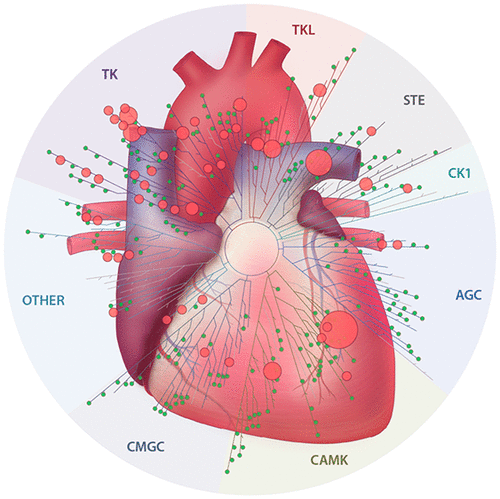当前位置:
X-MOL 学术
›
Chem. Res. Toxicol.
›
论文详情
Our official English website, www.x-mol.net, welcomes your feedback! (Note: you will need to create a separate account there.)
Cardiovascular Toxicity Induced by Kinase Inhibitors: Mechanisms and Preclinical Approaches.
Chemical Research in Toxicology ( IF 4.1 ) Pub Date : 2020-01-10 , DOI: 10.1021/acs.chemrestox.9b00387 Sarah D Lamore 1 , Rebecca A Kohnken 2 , Matthew F Peters 3 , Kyle L Kolaja 4
Chemical Research in Toxicology ( IF 4.1 ) Pub Date : 2020-01-10 , DOI: 10.1021/acs.chemrestox.9b00387 Sarah D Lamore 1 , Rebecca A Kohnken 2 , Matthew F Peters 3 , Kyle L Kolaja 4
Affiliation

|
Kinase inhibitors have transformed the treatment of many cancers and are showing the same promise for other indications including inflammatory diseases. This class of drugs is one of the most predominant in the pharmaceutical industry, but development and clinical utility is often limited by a broad spectrum of cardiovascular (CV) toxicities including QT prolongation and arrhythmia, left ventricular dysfunction, congestive heart failure, ischemia and myocardial infarction, and hypertension. In this review article, we provide a broad overview of the spectrum of CV events detected in clinical trials of kinase inhibitors and the known and proposed on- and off-target links between kinase inhibitor targets and these specific cardiotoxicities. We also examine the unique features of kinase inhibitors that have impeded complete mechanistic understanding of kinase inhibitor-associated cardiotoxicities and contributed to the disconnect between preclinical predictions and clinical findings. We then discuss various in vitro models currently in use that are amenable for high-throughput screening as well as lower throughput models that are valuable for mechanistic insight. These physiologically relevant models, together with newer "omic"-wide approaches will help to increase our understanding of the mechanisms underlying kinase inhibitor-associated cardiotoxicity and enable rational design of kinase inhibitors in the future.
中文翻译:

激酶抑制剂诱导的心血管毒性:机制和临床前方法。
激酶抑制剂已经改变了许多癌症的治疗方法,并且对包括炎症性疾病在内的其他适应症也显示出相同的希望。这类药物是制药行业中最主要的药物之一,但其开发和临床应用常常受到广泛的心血管(CV)毒性的限制,包括QT延长和心律不齐,左心功能不全,充血性心力衰竭,局部缺血和心肌梗塞和高血压。在这篇综述文章中,我们提供了在激酶抑制剂临床试验中检测到的CV事件频谱的广泛概述,以及激酶抑制剂靶标与这些特定的心脏毒性之间已知的和拟议的靶标和靶标外联系。我们还检查了激酶抑制剂的独特功能,这些功能妨碍了对激酶抑制剂相关的心脏毒性的完整机理的理解,并促成了临床前预测与临床发现之间的脱节。然后,我们讨论了当前正在使用的适用于高通量筛选的各种体外模型,以及对机械分析有用的低通量模型。这些生理上相关的模型,以及更新的“全基因组”方法,将有助于增进我们对激酶抑制剂相关心脏毒性机制的了解,并在未来使激酶抑制剂的合理设计成为可能。然后,我们讨论了当前正在使用的适用于高通量筛选的各种体外模型,以及对机械分析有用的低通量模型。这些生理上相关的模型,以及更新的“全基因组”方法,将有助于增进我们对激酶抑制剂相关心脏毒性机制的了解,并在未来使激酶抑制剂的合理设计成为可能。然后,我们讨论了当前正在使用的适用于高通量筛选的各种体外模型,以及对机械分析有用的低通量模型。这些生理上相关的模型,以及更新的“全基因组”方法,将有助于增进我们对激酶抑制剂相关心脏毒性机制的了解,并在未来使激酶抑制剂的合理设计成为可能。
更新日期:2020-01-10
中文翻译:

激酶抑制剂诱导的心血管毒性:机制和临床前方法。
激酶抑制剂已经改变了许多癌症的治疗方法,并且对包括炎症性疾病在内的其他适应症也显示出相同的希望。这类药物是制药行业中最主要的药物之一,但其开发和临床应用常常受到广泛的心血管(CV)毒性的限制,包括QT延长和心律不齐,左心功能不全,充血性心力衰竭,局部缺血和心肌梗塞和高血压。在这篇综述文章中,我们提供了在激酶抑制剂临床试验中检测到的CV事件频谱的广泛概述,以及激酶抑制剂靶标与这些特定的心脏毒性之间已知的和拟议的靶标和靶标外联系。我们还检查了激酶抑制剂的独特功能,这些功能妨碍了对激酶抑制剂相关的心脏毒性的完整机理的理解,并促成了临床前预测与临床发现之间的脱节。然后,我们讨论了当前正在使用的适用于高通量筛选的各种体外模型,以及对机械分析有用的低通量模型。这些生理上相关的模型,以及更新的“全基因组”方法,将有助于增进我们对激酶抑制剂相关心脏毒性机制的了解,并在未来使激酶抑制剂的合理设计成为可能。然后,我们讨论了当前正在使用的适用于高通量筛选的各种体外模型,以及对机械分析有用的低通量模型。这些生理上相关的模型,以及更新的“全基因组”方法,将有助于增进我们对激酶抑制剂相关心脏毒性机制的了解,并在未来使激酶抑制剂的合理设计成为可能。然后,我们讨论了当前正在使用的适用于高通量筛选的各种体外模型,以及对机械分析有用的低通量模型。这些生理上相关的模型,以及更新的“全基因组”方法,将有助于增进我们对激酶抑制剂相关心脏毒性机制的了解,并在未来使激酶抑制剂的合理设计成为可能。



























 京公网安备 11010802027423号
京公网安备 11010802027423号